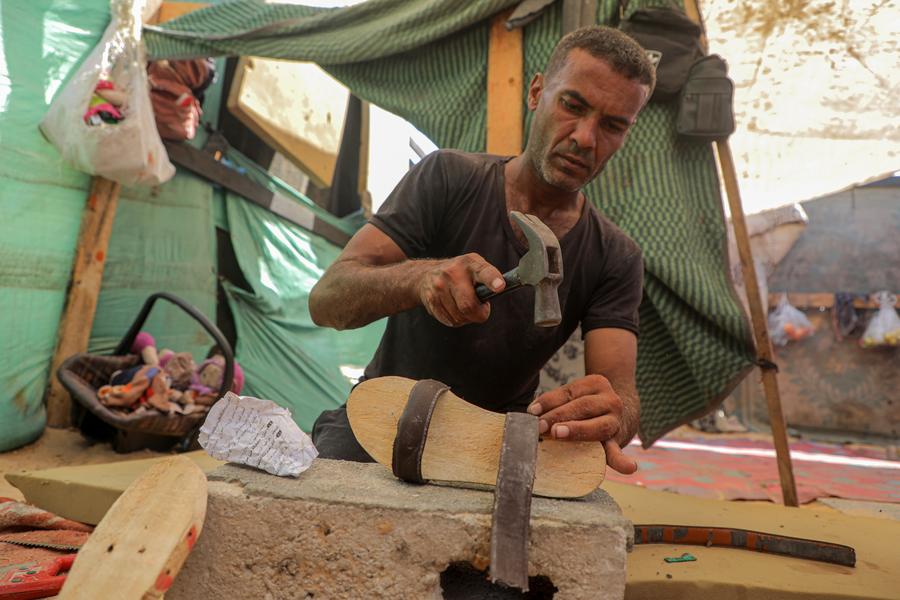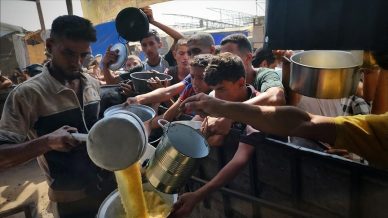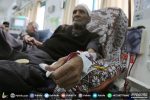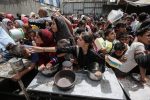By Wafa Aludaini
Along a busy roadside, the cobbler Abu Ezz Barghout sits at a small table and chair under a tarpaulin, fixing shoes and slippers for people who gather in a long line in front of his stall.
“We’ve never witnessed this number of customers coming to mend their footwear before,” he says. “They bring totally damaged shoes. Before the ongoing war, we prefer throwing them away rather than repairing them, but now we have no choice.”
The sewing operation is manual, a result of the Israeli occupation cutting off electricity and the lack of fuel to generate machines. Repairs require regular sewing kits, a needle or awl, glue and threads, which have become scarce recently. The lack of standard materials pushes some cobblers to fashion slippers out of whatever materials are readily available. “Some people made pair of flip-flops from used bottles, crushing them into the shape of slippers then tying them with suitable thread or fabric,” Abu Ezz says. He has also used cork and other similar materials to make shoes for sale. Sights of barefooted children or people wearing mismatched pairs of shoes or slippers have become normal these days.
Throughout the eleven months of Israeli genocide, people have been forced to walk miles over rubble, glass, and other debris to gather food and water for their families or to escape the bombardment, leaving most people in Gaza utterly destitute. People are forced to share shoes, walk barefoot, or otherwise invent ill-fitting alternatives to cope with the devastated and hazardous streets.
The Israeli embargo has severely restricted shoes of all styles and sizes since October 2023, letting extremely few shoes enter into Gaza’s markets, where the scarcity has led to soaring prices, particularly slipper styles which are commonly used in the displacement camps and amongst the poorer classes.
Palestinians don’t stop at fixing footwear. Some shoemakers have also fabricated slippers and flip-flops from locally available items including leather, cork, and wood, coming up with ways to cope with the scarcity. Carpenter Saber Dawwas, 39, manufactures flip-flops fashioned from wood. The shoes are extremely similar in style to clogs, a style of footwear that has a thick, rigid sole typically made of wood that were used in ancient eras. Dawwas describes to PIC how he makes the clogs in his displacement zone in al-Mawasi, a coastal area designated as “a humanitarian zone” by Israeli occupation army but it has never been spared from the Israeli bombardment. ” I cut the pieces of wood using a small saw, after taking the necessary measurements for my children’s feet by tracing them on the pieces to be cut.” When he finishes cutting the wood according to the size of each child’s foot, he carves it carefully using a stone, then places thin, colored cork paper to cover the wooden sole, adding a piece of cloth to ensure the tightness and stability of the foot in the slipper.
When Dawwas and his family were forced to evacuate from Jabaliya to the southern areas, they were in a rush under the Israeli fire. “We have been wearing the same pairs of shoes for eleven months before they worn out and our toes started to stick out,” Dawwas, a father to five children, says. “My children were squeezing their feet into ill-fitting shoes as they continue to grow, and it is very important to find even badly-fitting footwear for my children to be able to walk in the muddy streets of the tent zones,” to protect children from common diseases and getting injured from the rubble and hot sand of bombed-out Gaza.
Soon, his neighbors noticed him making the wooden slippers, and began requesting him to make some for their children. Saber used basic carpentry tools to make the pieces.
The clogs have wooden soles and straps made of rubber bands or worn-out cloth. But finding more wood is an ongoing challenge, as Palestinians need it for cooking and making bread.
Israel’s alibi for its genocide and embargo, a “war on Hamas,” echoed ad nauseam in the Western corporate media, has nothing to do with banning such goods from entering the devastated enclave. The main aim is cleansing the costal enclave by making circumstances unlivable to encourage the voluntary migration, yet the Palestinians patient survival initiatives show that their will is unbreakable.
-Wafa Aludaini is a Gaza-based journalist. She contributed this article to the Palestinian Information Center.














